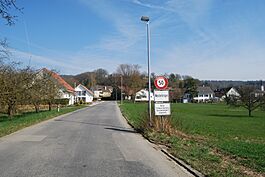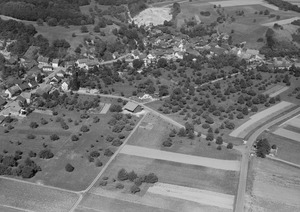Wasterkingen facts for kids
Quick facts for kids
Wasterkingen
|
||
|---|---|---|
 |
||
|
||
| Country | Switzerland | |
| Canton | Zurich | |
| District | Bülach | |
| Area | ||
| • Total | 3.96 km2 (1.53 sq mi) | |
| Elevation | 393 m (1,289 ft) | |
| Population
(Dec 2020 )
|
||
| • Total | 568 | |
| • Density | 143.43/km2 (371.5/sq mi) | |
| Postal code |
8195
|
|
| Surrounded by | Hohentengen am Hochrhein (DE-BW), Hüntwangen, Klettgau (DE-BW), Wil | |
Wasterkingen is a small town, also known as a municipality, in Switzerland. It is located in the canton of Zürich. This town is part of the Bülach district. It is a quiet place with a mix of nature and homes.
Contents
A Look Back: Wasterkingen's History
Wasterkingen celebrated a big milestone in 2002. The town turned 900 years old! The people of Wasterkingen, sometimes called Wasterkingener, threw a huge party. There were many fun and interesting things to do. Everyone learned more about the long history of this small village.
Exploring Wasterkingen's Geography
Wasterkingen covers an area of about 3.9 square kilometers. A large part of this land, about 46.4%, is used for farming. Forests cover another big part, about 43.4% of the area. The remaining land, about 10.2%, is where buildings and roads are located.
Border Crossing to Germany
Wasterkingen has a special feature: a road that crosses directly into Germany. The German town of Günzgen, in the state of Baden-Württemberg, is just on the other side of this border.
People and Life in Wasterkingen
Wasterkingen has a population of 568 people (as of 31 December 2020). About 7.7% of the people living here are from other countries. Over the last ten years, the number of people living in Wasterkingen has grown by about 3.7%.
Languages Spoken in Wasterkingen
Most people in Wasterkingen speak German. About 98% of the population uses German as their main language. French is the second most common language, spoken by about 0.7% of people. English is third, spoken by about 0.5%.
Age Groups in the Town
Looking at the age of people in Wasterkingen (as of 2000):
- Children and teenagers (0–19 years old) make up about 28.6% of the population.
- Adults (20–64 years old) make up the largest group, about 60.4%.
- Seniors (over 64 years old) make up about 11.1%.
Education and Work in Wasterkingen
Many adults in Wasterkingen have a good education. About 91.8% of people aged 25 to 64 have completed higher education or vocational training.
The unemployment rate in Wasterkingen is quite low, at about 1.25%. This means most people who want to work can find a job.
How People Work: Economic Sectors
As of 2005, people in Wasterkingen work in different types of jobs:
- Primary Sector: This includes jobs like farming and forestry. About 31 people work in this sector, with 11 businesses.
- Secondary Sector: This involves making things, like in factories or construction. About 4 people work in this sector, with 3 businesses.
- Tertiary Sector: This covers service jobs, like shops, offices, or healthcare. About 21 people work in this sector, with 7 businesses.





